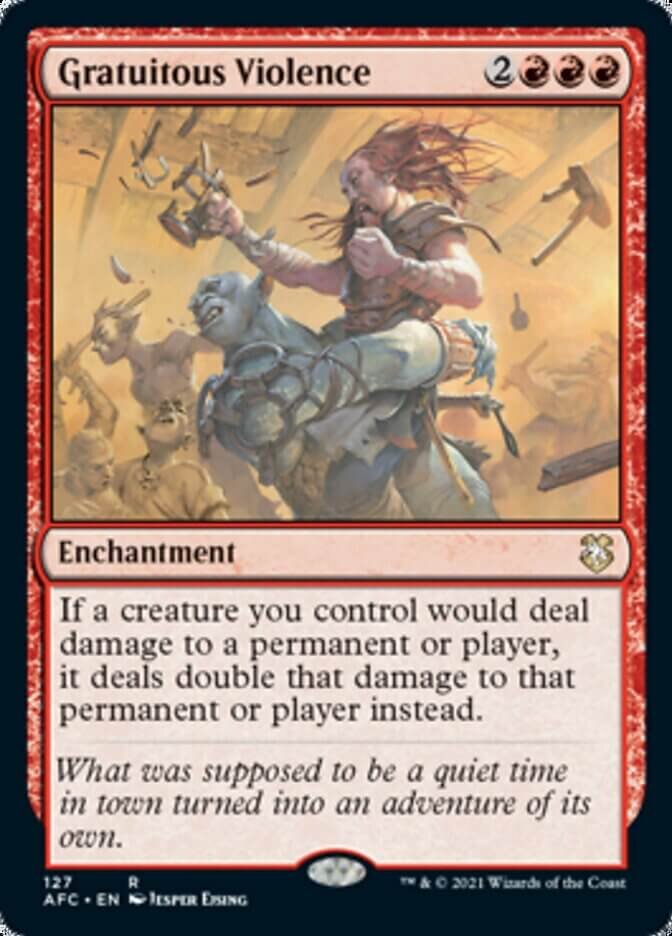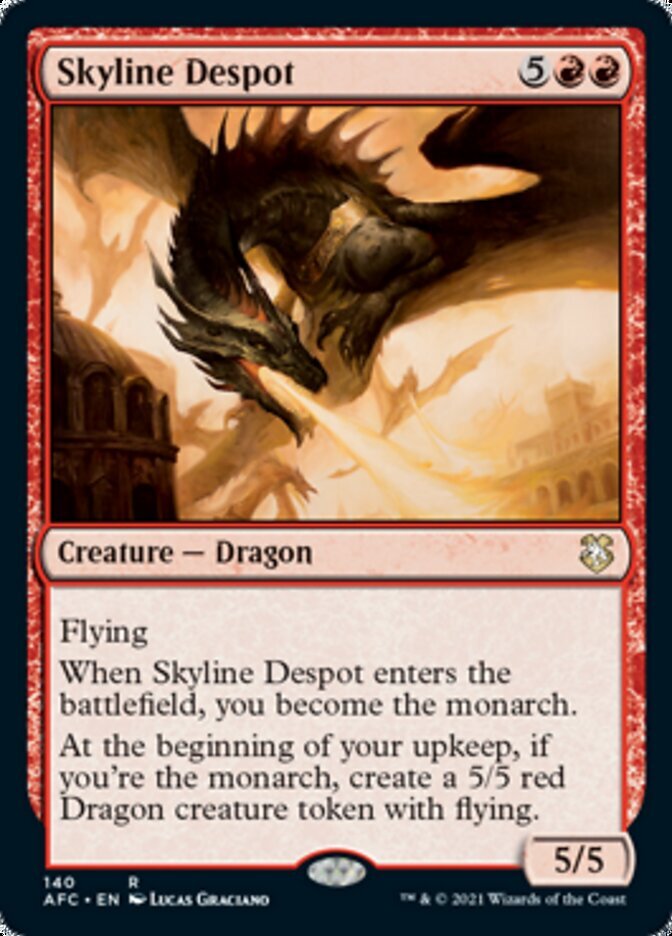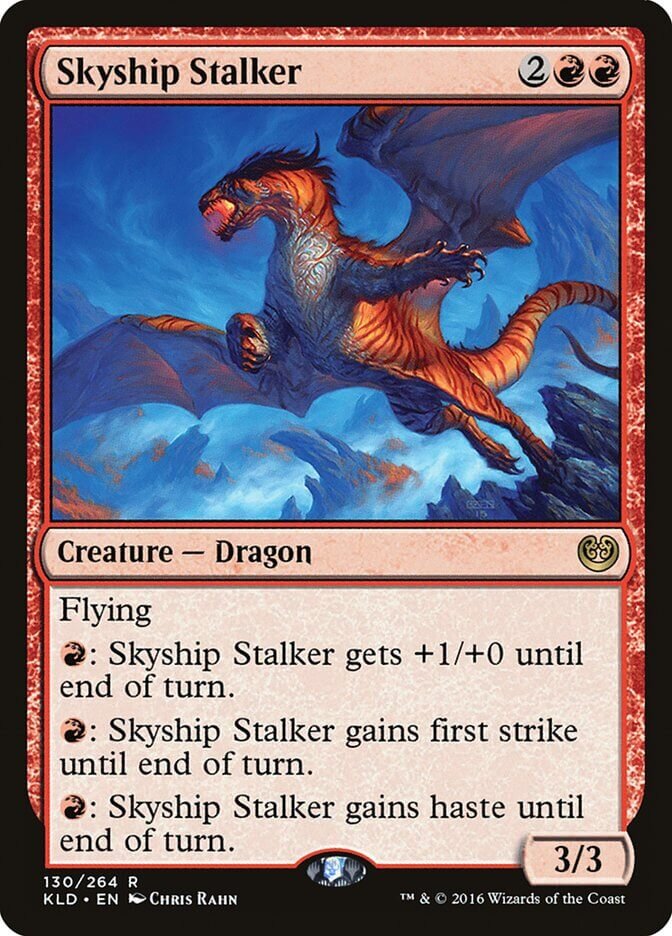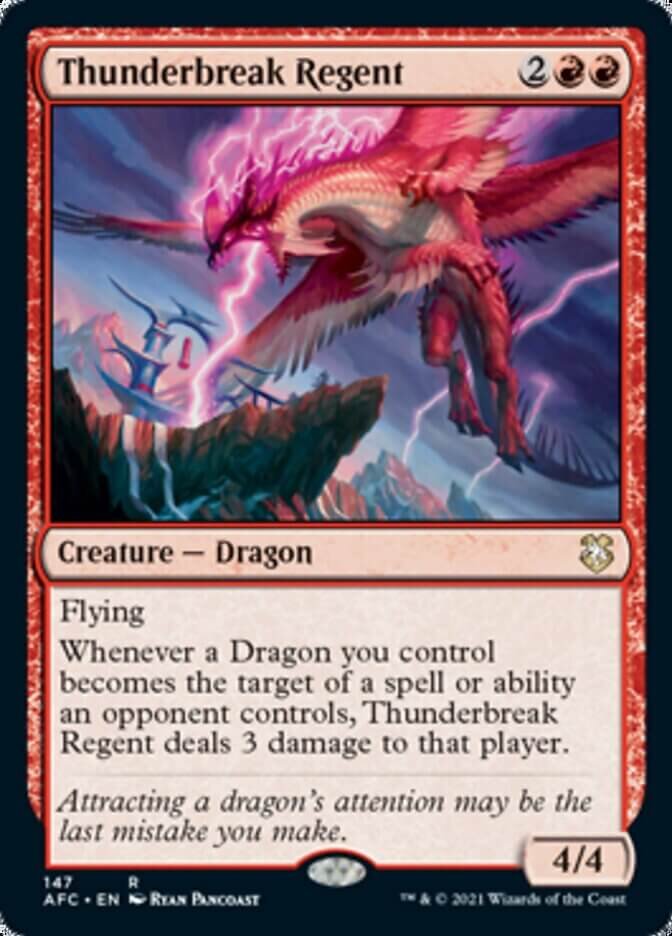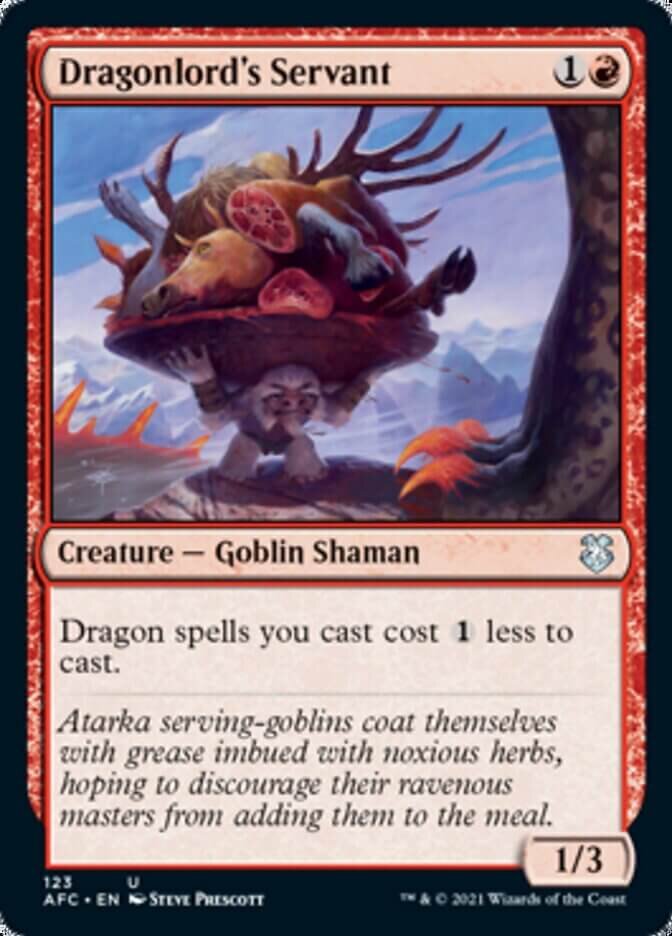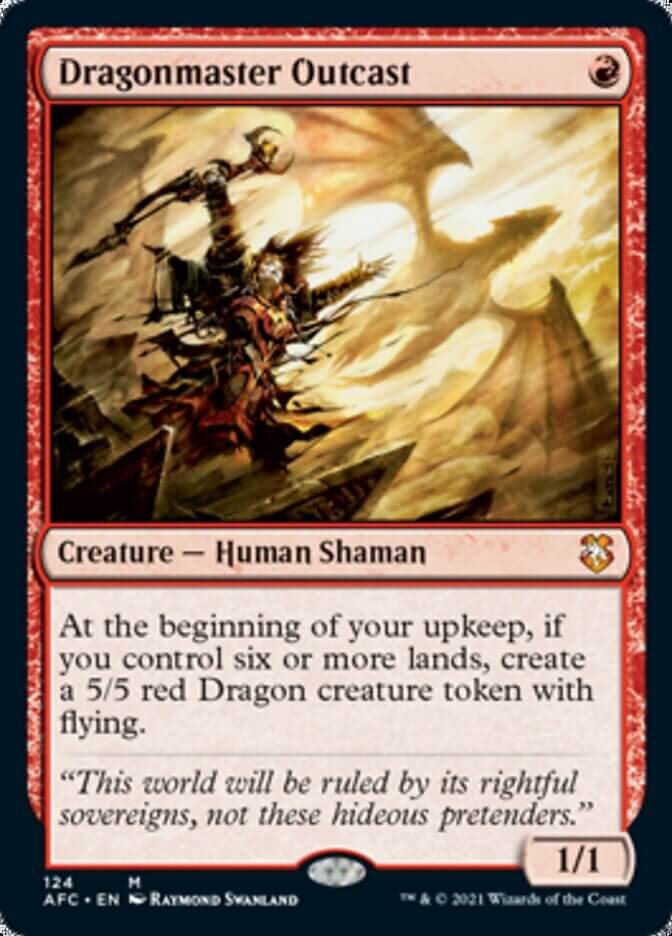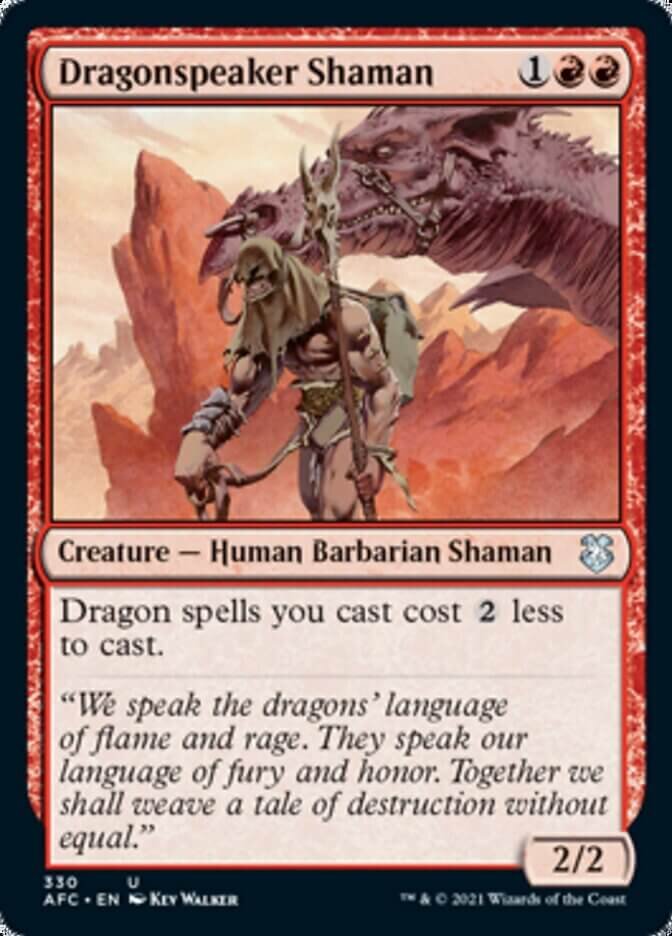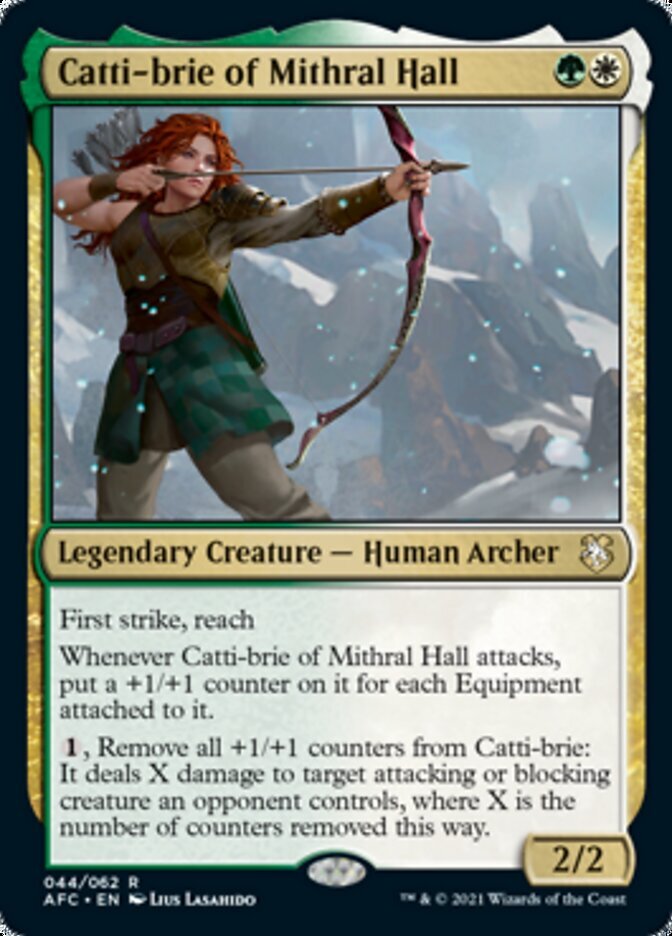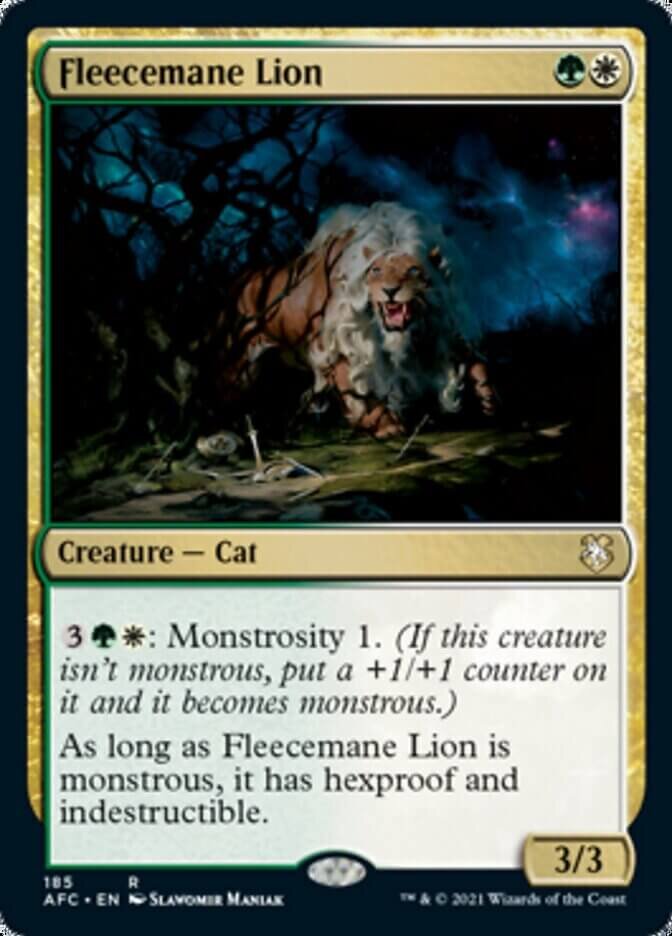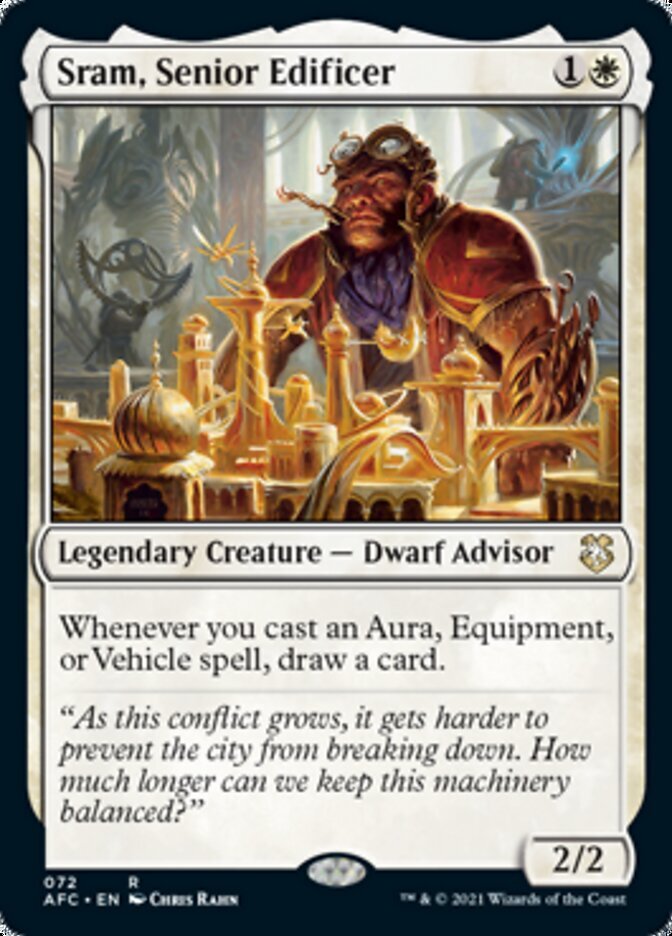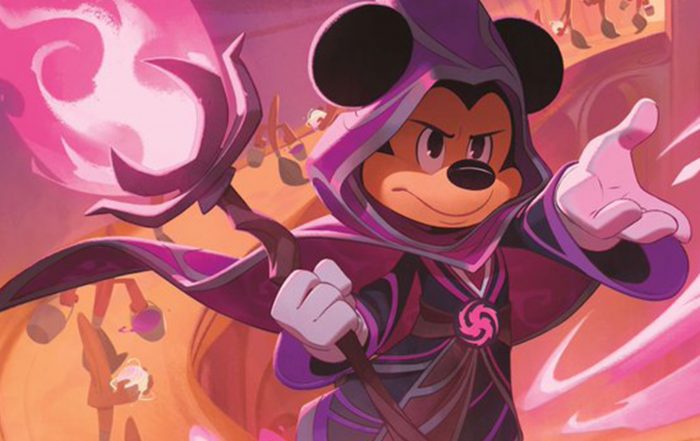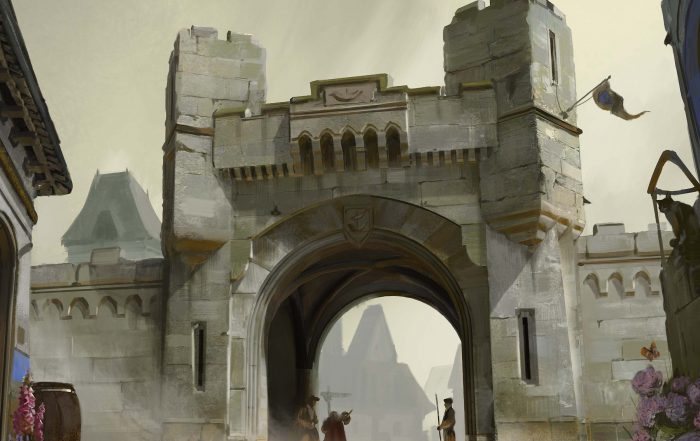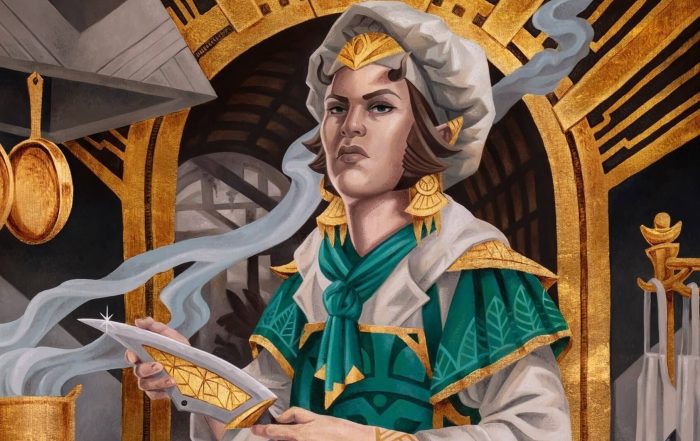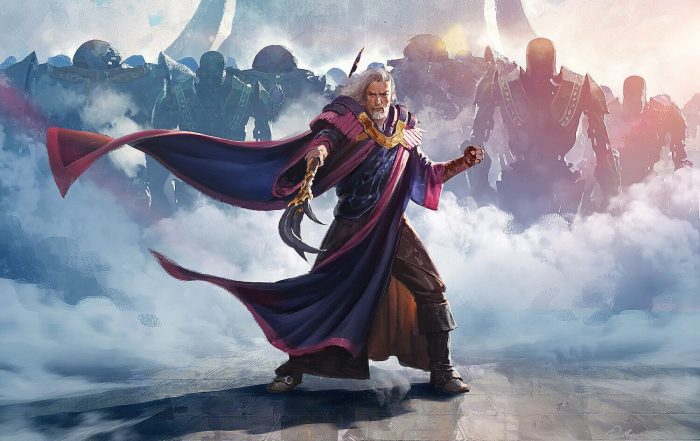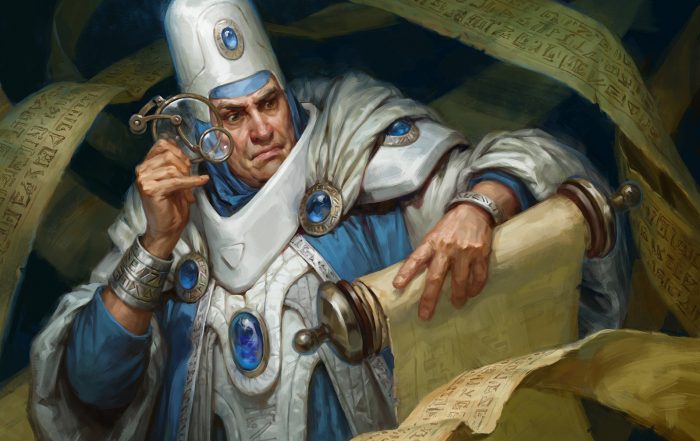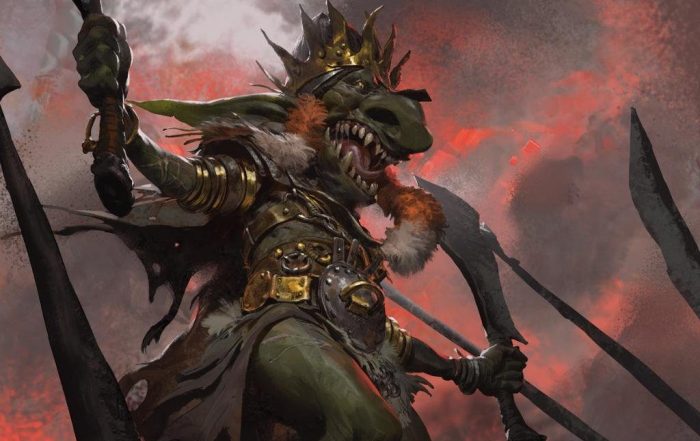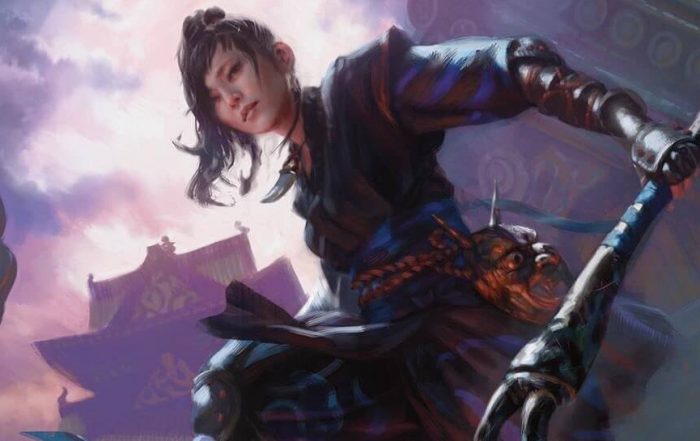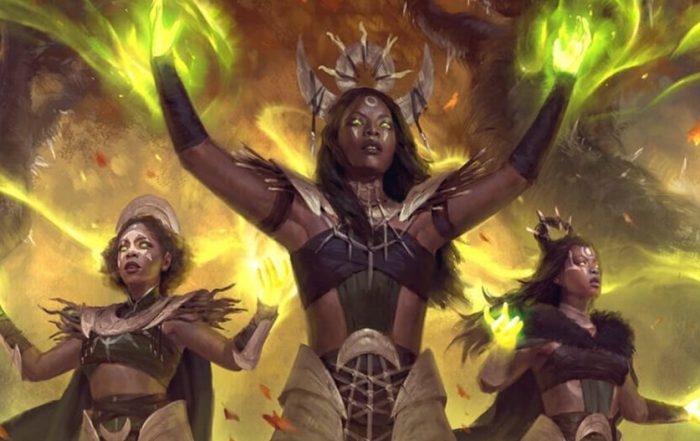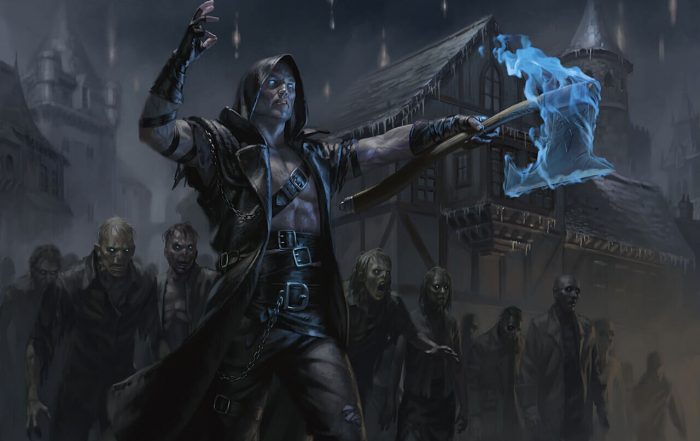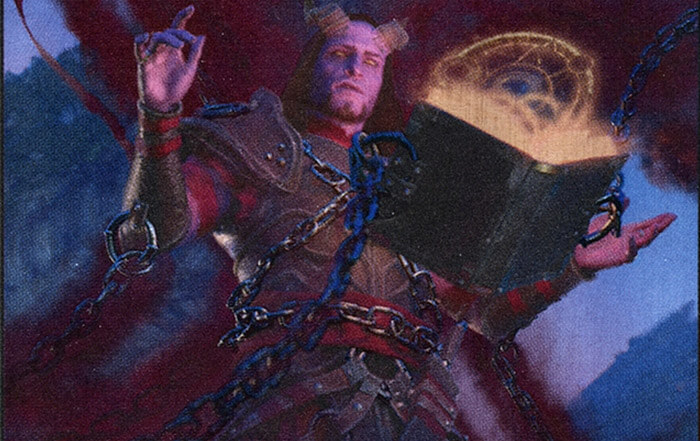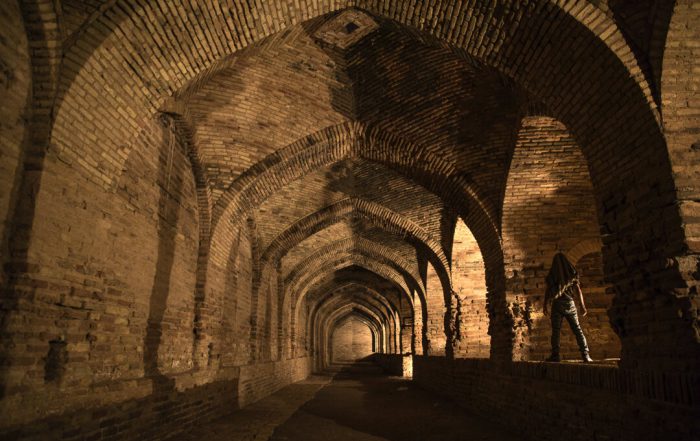Review D&D Commander Decks – Part 1
Commander Decks from the Forgotten Realms Part 1
Draconic Rage and Aura of Courage
Author: David Merker-Schwendinger
In the course of the big Magic the Gathering spoiler for the Adventures in the Forgotten Realms-edition, the first cards for four Commander decks were presented in advance. Two of these decks, which have already been released, will be examined in the following article. The four decks are called Planar Portal, Dungeons of Death, Draconic Rage and Aura of Courage.
Innovative design form
If you take a first look at the packaging of the respective set, the first thing that catches your eye is the unusual design. A draconic scale armour covers the front and back of the deck box, matching the Dungeons and Dragons theme. The light effect on the scales is designed in the colours that the respective commander possesses. Also, again included is a life point counter, ranging from 0 to 40.
Draconic Rage
The Main Commander
The main commander of the “dragon-themed” deck is Vrondiss, Rage of Ancients, a green-red dragon barbarian (3RG). This commander is based on a mechanic that is more focused in the Dungeons&Dragons edition, the rolling of a die.
Vrondiss ability is based on self-inflicting damage and is also linked to dice. Once a die is rolled, Vrondiss inflicts a point of damage on himself, this triggers his main ability to put a 5/4 green-red Dragon Spirit token into play each time he is dealt damage with the addition of “When this creature deals damage, sacrifice it.” is put into play.
Thus, the Commander can be played both passively-defensively and actively-aggressively.
The Second Commander
The second possible commander is a legendary dragon, Klauth, Unrivaled Ancient.
The mechanics of this legendary creature head in a completely different direction than those of Vrondiss. For seven mana, 5RG, you can put this dragon, equipped with haste and flying, into play. This cost seems very high, but it is compensated by his ability.
Each time Klauth attacks, the player controlling him may add X mana to his mana pool in any colour combination, where X is the total power of the attacking creatures.
In a deck named after dragons, a large mana pool provides the basis for strengthening your board and generating high attack power. Combined with Skyship Stalker or Scourge of Valkas, this ability has deadly potential.
The Third Commander
The third commander possibility is Wulfgar of Icewind Dale, a legendary barbarian penned by R. A. Salvatore.
His ability is a strong support for the rest of the deck and its play style – no matter if Wulfgar is played as commander or regular creature – because every triggered Ability of a permanent, which is triggered by attacking creatures, is effected another time.
Thus, Wulfgar fits into many green-red decks that are aggressive and rely on effects triggered by and in combat phases.
It should be noted that it is a nice Easteregg for the lore of the deck to include a barbarian who is widely known in the Forgotten Realms for slaying a white dragon and stealing its hoard.
Card Distribution
The distribution of cards in the deck is divided into 40 lands, which can be a large number for commander decks, nine artifact cards, eight enchantment cards, 17 sorceries and instant spells, and 26 creatures, which ultimately complete the deck.
The composition of the two mana colours red and green makes sense for an aggressively conceived and built deck. A first look at the red cards reveals two reprints from older editions, including Anger and Gratuitous Violence.
Both provide the player with a good base for high damage and fast-moving attacks. Anger‘s ability gives haste if the player controls Mountains and the incarnation creature is in his graveyard. The second one is similar to Furnace of Rath, but unlike it, it does not target your own creatures. It doubles the damage dealt to a player or a permanent.
The Dragons
At this point, the dragons that give their name should not be ignored either, 17 of the creature cards bear this race as a characteristic. Two in particular stand out, the Skyline Despot and the Thunderbreak Regent.
The Despot gives the controlling player Monarch status, and at the start of each upkeep a 5/5 red Dragon creature with flying ability is put into play as long as you remain in possession of that status.
In combination with Klauth, the Despot can be a very strong combo-card, but the cost of this card, 5RR, can be a deterrent if you don’t cast it from a mana ability. If you look at D&D lore, the Skyline Despot is reminiscent of some of the first dragons, which have the reputation of being able to create their own kind.
The Regent, on the other hand, offers for a relatively low mana cost (2RR) the ability to inflict three points of damage to a player as soon as a dragon becomes the target of an opponent’s spell or ability.
If this card is used later in the game, when several dragons (tokens) have already found their way into the game and are destroyed or targeted, good damage can be generated.
Shivan Hellkite allows with its activated ability to inflict damage on Vrondiss to generate dragon spirit tokens. The comparatively high costs of the dragon creature cards can be absorbed well by the high mana count in the deck, further support is provided by the Dragonmaster Outcast, the Dragonspeaker Shaman or the Dragonlord’s Servant.
To buff the attack power, a creature card like Terror of Mount Velus, which gives double strike to all creatures under the player’s control until the end of the turn, is of great use.
Atarka, World Render, which provides double strike to all dragons, gives the player a permanent way to increase their own damage. A passive way to inflict damage on an opponent is the Scourge of Valkas. This inflicts X points of damage to an opposing player as soon as he himself or another dragon comes into play, where X is the number of dragons controlled.
In a game with several players, chaos is inevitable, which can be supported by the Chaos Dragon. This provides one of the few abilities in the deck to roll a die and trigger Vrondiss ability. Each player rolls a W20, the Chaos Dragon must attack every turn, but cannot declare the person with the highest roll as a target.
Enchantments
Two of the enchantments in the deck offer great power for high damage output, Gratuitous Violence and Warstorm Surge. Gratuitous Violence doubles the damage dealt by a controlled creature.
Warstorm Surge makes a creature deal damage equal to its power to any target as soon as it comes into play. If Atarka is also in play, a devastating attack can be made with Double Strike.
Two enchantments let the player activate Vrondiss‘ ability, Maddening Hex and the Barbarian Class. The former moves randomly between participating players.
The Barbarian Class remains in play and allows the player to roll with advantage, i.e., use two dice and use the higher result.
Sorcery and Instant Cards
Four of the Sorcery and Instant cards offer the ability to search mana from the deck or play additional mana, three of them at a low cost (Rampant Growth, Cultivate and Explore).
Wild Endeavor triggers Vrondiss and offers a combined ability of generating beast tokens and picking lands from your library. Five more cards offer damage spells, the remaining 8 allow the player to, for example, boost their own creatures, draw cards, or gain life points.
Artifacts
The majority of the artifacts included in the deck generate additional mana for the player to enable the creatures that form the core of the deck.
Two artifacts, Heirloom Blade and the Sword of Hours, boost the controlled creatures. The latter lets the player cast a W12.
The Component Pouch, which serves as the basis for many spellcasting classes in D&D, and the Bag of Tricks provides another opportunity to roll a die and activate Vrondiss.
Conclusion
All in all, Draconic Rage is a solid pre-built Commander deck that relies on damage and aggression to slowly but surely crush the opponent and keep them small. The high land count provides a good basis to summon them, supported by artifacts included in the deck or creature cards like Klauth or the Savage Ventmaw.
Personally, it is disappointing that only nine out of 100 cards offer the possibility to activate the mechanic of throwing dice and thus trigger Vrondiss. I would have liked to see more cards in the deck that address this and support the commander through this mechanism.
The prefabricated decks are a bit slower in their playstyle than custom decks and can be kept under control, especially in the early rounds. In the long run, however, the deck can pose a great danger if small or large boardwipes do not take place in time.
Various cards can add further power to the deck, such as the Goblin Anarchomancer, which makes green and red spells cheaper by one colourless mana, the Mage Slayer, which promises unblockable damage, or the Rhythm of the Wild enchantment, which protects your own creature spells from counterspells.
Aura of Courage
The First Commander
This commander deck is related to auras, enchantments and equipments.
The first commander of the second deck, which features the three colours green, white and blue, is Galea, Kindler of Hope.
The elven 4/4 warrior card with vigilance provides a good basis for the intentional structure of the deck. It offers the player, for a low mana cost, 1GWB, the ability to look at the top card of their library at any time and cast aura and equipment spells from the library.
These, when cast directly from the deck in this way, are immediately applied to a creature the player controls.
This is important for the mechanics of the deck, which rely on enchantments, auras and artifacts to increase the strength of their creatures and buff them heavily.
The Second Commander
The second commander option is Storvald, Frost Giant Jarl.
For its relatively high mana cost of 7GWB, it comes with Ward 3 and offers the player two abilities once it comes into play or attacks: modifying a creature’s base power and defense to 7/7, and/or reducing a creature to 1/1.
This can greatly affect the way your opponent will block your attacks. The protection Storvald offers other creatures with his passive ability is not to be ignored.
Individual damage or destruction spells can be increased in cost, so especially with a low mana pool, it must be carefully weighed by the opponent whether there is a need to destroy a creature or not.
Fleecemane Lion
Another usable creature included in the deck is Fleecemane Lion. This is playable for two mana, GW, and can be massively buffed with its Monstrosity 1 ability. This lays the groundwork for future equipment and enchantment cards attached to it.
Cold-Eyed Selkie, 1 G/B G/B, provides the ability to quickly get a number of new hand cards whenever she deals combat damage to an opposing player. Islandwalk allows her to attack some players directly, otherwise she can be made mobile with enchantments that provide flying ability.
Sram, Senior Edificer
Another essential card for the deck is Sram, Senior Edificer, a reprint. Since the player’s hand cards will be exhausted quickly and Cold-Eyed Selkie may already be in the graveyard, Sram can be of great use.
The dwarf, which also shows up due to the low cost of 1W, allows the player to draw a new card as soon as you play an Aura, Equipment or Vehicle card.
Cattie-Brie
Catti-Brie, an adventurer from the ranks of the Companions of the Hall, is also included in the deck, for the mana cost GW.
Equipped with range and first strike, she is a good defender in early turns, but also serves as an attacker.
Her ability combines well with the equipment cards included in the deck. As soon as Catti-Brie attacks, she gets a +1/+1 token for each piece of equipment attached to her.
If you pay a colourless mana, you can remove all tokens from her and deal X damage to an attacking or blocking creature, where X is the number of tokens removed.
Combo with Sword of Hours
A good combination here is Sword of Hours, which puts a +1/+1 token on the equipped creature each time it attacks. As soon as the equipped creature inflicts combat damage, one of the newly built mechanics of the Forgotten Realms-Edition triggers, the dice roll. 1d12 may be rolled.
If the result is higher than the damage inflicted, or 12 is rolled, the tokens on the creature may be doubled. Equally, useful are the Basilisk Collar, the Colossus Hammer or the Belt of Giant Strength.
Fey Steed
Fey Steed, 2WW, is a good support card when it comes to the attack phase. When the commander is buffed with equipment and enchantments, the Steed can support and protect him in the attack.
Its first ability allows it to make another attacking creature indestructible until the end of the turn. The second lets the player draw cards as soon as one of his own creatures or a planeswalker becomes the target of an ability or spell controlled by the opponent.
This is the third card in the deck that provides a supply of cards.
Puresteel Paladin
A fourth creature that can solve the “hand card problem” is the Puresteel Paladin, which can also be found as a reprint in the deck. Similar to Sram, a card may be drawn as soon as an equipment comes into play under your control. The Metalcraft ability reduces the equipment cost to 0 as long as three or more artifacts are controlled.
Finally, the Riverwise Augur is used to get new cards into the hand. In addition to these creature cards, the enchantments Greater Good (Reprint), Abundant Growth, Netherese Puzzle-Ward, Curse of Verbosity and Angelic Gift, or the spells Brainstorm and Serum Visions serve to steadily draw and keep cards in hand.
Imprisoned in the Moon is a cheap and effective way, 2B, to slow down the opponent, for example, to get their Commander out of the game for some time.
Instants
One instant that should not be ignored is Ride the Avalanche. This gives the next cast spell flash, plus you can put X +1/+1 counters on a creature, where X is the mana cost of the spell. Together with Catti-Brie, this is a very strong combination.
Weaknesses of the Deck
A weakness of the deck becomes apparent as soon as many cards have landed in the graveyard, and it becomes difficult to bring them back into play. However, two cards can counteract this. Mantle of the Ancients gives the creature +1/+1 for each Aura or Equipment card attached to it. Furthermore, once the Mantle comes into play, the player may return any number of Aura and Equipment cards from the graveyard to play.
These are attached to the creature enchanted with the Mantle. The usefulness of Song of Inspiration must be carefully weighed by the player, as it is the only return card in the deck that can also return creatures.
Card Distribution
The deck contains 38 lands, 16 creatures (Commander included), 15 aura and enchantment cards, 17 equipment cards and 14 spontaneous spells and sorceries. The low number of creature cards in the deck is immediately obvious.
Aura of Courage tries to counteract this with some artifacts, enchantments and spells, for example Verdant Embrace, Moonsilver Spear or Valiant Endeavor. These bring tokens into play that can provide valuable support once decimation of your creatures has set in.
Style of Play
The basic idea of the deck is to turn individual creatures into bulwarks of defense or weapons of destruction through auras and equipment, but this failed in some trial games due to the low number of creatures in the deck.
Early boardwipes quickly slowed the deck down. You rarely recover from many of these destruction moves, as only one card, the aforementioned Song of Inspiration, allows you to bring creatures back from the graveyard. Two boardwipe cards of their own, Winds of Rath and Valiant Endeavor, offer their own way to turn the game around. The former destroys all unenchanted creatures, these cannot be regenerated, Endeavor destroys 1d6 creatures and puts 1d6 white 2/2 Knight tokens into play.
Necessary Changes
This Commander deck needs bigger changes from a personal perspective to hold up longer against faster and more aggressive decks.
- The Moon-Blessed Cleric, which was introduced with the Adventures in the Forgotten Realms – Edition, would fit well into the deck to get a needed enchantment card faster.
- So would Sterling Grove, which protects your own enchantments and allows you to get an enchantment card out of the deck.
- Furthermore, Sigarda’s Aid would be attractive to play powerful auras and equipment spells at the right time to catch the opponent off guard.
- Another creature that harmonizes well with the idea of the deck would be the Esper Sentinel, which can generate a good supply of hand cards.
- The Sanctum Weaver provides the necessary mana.
- The strength of Sythis, Harvest’s Hand is to gain life points and draw cards.
- Or stronger creatures like Halvar, God of Battle or the Sun Titan, which allow you to put a permanent card with a mana cost of three or less from the graveyard back into play, can be of great use. The latter is even part of the Dungeons of Death commander deck.
- To be able to get the right equipment, spells like Open the Armory are of great use, which can be a very strong combination when combined with Stoneforge Mystic and Sigarda’s Aid, for example.
Deck Comparison
If you compare both Commander decks directly, Draconic Rage is clearly the more aggressive deck at first glance, offering many card combinations to increase your own damage and inflict it actively or passively.
Sophisticated card combinations or game mechanics are not to be found in this Commander deck.
Aura of Courage, on the other hand, can be played both actively and passively, which gives the player more possibilities to develop his own style.
Draconic Rage quickly generates tokens with Vrondiss as commander, which allow strong combinations and harmonize well with many cards in the deck. It clearly relies on strong creatures, of which a large number are included in the deck, and focuses on damage distribution and destruction.
Aura of Courage and its commander Galea focus on quickly supplying the available creatures with auras and equipment to protect them, raise their strength and achieve victory via the damage they cause.
In trial games, Draconic Rage, although rather slow in game flow and build-up, held its own well. The dragons offered good attack power as well as defense.
Aura of Courage, on the other hand, often failed due to low creature count and early boardwipes, sometimes even without being able to really counter other (faster) decks with their high density of creature cards.
Another problem was not having an enchantment, aura or equipment card in hand or as the top card of the library that fits the current situation.
Conclusion
All in all, the pre-built decks are slower to build and develop compared to self-built, faster-to-play commander decks.
However, they can keep up solidly in the later stages of the game. Among the four decks of the Forgotten Realms Commander sets, I would personally place Aura of Courage in the lower half due to its “playability”, while Draconic Rage is definitely in the upper half.
About the Author
David Merker-Schwendinger started playing Magic: The Gathering as a teenager. His first Deck was a Mirrodin Preconstructed Deck.
Over the years, he developed an interest in role-playing games, which was sparked during his Archeological studies at university.
The Magic card collection kept growing during his Master studies of Austrian history. Some topics he studied, like heraldic, came in handy for his role-playing storytelling.
He is the host of a YouTube channel (NerdNavigator) where he features the Austrian D&D community and Dungeons’ and Dragons in general.
Booster Drafting with friends and exploring Ravnica with his Dungeon and Dragons party are among his favorite things to do in his free time.

All Articles by David Merker-Schwendinger
How To Play Disney Lorcana
Here's everything you need to know about the gameplay of the new card game Disney Lorcana. In our latest article, David explains to you everything you need to know about Ink, Glimmer, turn structure, card types and anything else surrounding the gameplay of Lorcana.
Commander Legends 2 – Battle for Baldur’s Gate
Commander Legends 2: Battle for Baldur's Gate released a few weeks ago. Our author David takes a closer look at the set and tells us about what Beasts, Dragons and other mythical creatures he is really excited about!
Streets of New Capenna: The Most Powerful Commanders
Streets of New Capenna is out right now and with it come a few really strong Commanders! In this blog entry, we are going to present you the most powerful Commanders from Streets of New Commander. Maybe you get to play some of them before they eventually get banned?
The Best Underrated & Most Overrated Commanders
In today’s article, David is taking a closer look at the Commander table and filters through different choices for the top leaders of current decks. If you’re interested in getting to know his picks for the best underrated and the most overrated Commanders in Magic: The Gathering, keep on reading right here.
The Best 5 Commanders in 2022
David is presenting his top 5 list of Commanders he thinks who are the strongest choices, he is not yet playing in Commander. From funky picks to powerful format mainstays. There's a legend for everyone.
Commander Deck Tech: Goblins
Squee and his minions are David's favorite Commander deck at the moment. Read what makes the deck work and what combos you can pull off with it.
Ninjas in Legacy
Tribal decks in Magic the Gathering are fun. What is more fun than the Ninja tribe? Not much. Sneak your way to victory in Legacy with this version of Ninjas, including tips, tricks and a sideboard guide by the Master Ninja, Zen Takahashi
Review Innistrad: Midnight Hunt Commander Deck – Part 2
Magic the Gathering's latest release, Innistrad: Midnight Hunt, comes with a new Commander Deck as well. The main theme of Coven Counters Unleashed is, different powers among your creatures to trigger the new Coven keyword. David is giving the deck a test drive and shares what he thinks about it.
Review Innistrad: Midnight Hunt Commander Deck – Part 1
Magic the Gathering's latest release, Innistrad: Midnight Hunt, comes with a new Commander Deck as well. The main theme of Undead Unleashed is, you probably have guessed it already: ZOMBIES! David is giving the deck a test drive and shares what he thinks about the deck.
Review D&D Commander Decks – Part 2
David is back to try and test the remaining two AFR Commander Decks. Find out if this is a good investment for avid Magic the Gathering Commander players or if you should put your money elsewhere.
Review D&D Commander Decks – Part 1
David is back, and he not only checked out one or two of the four Commander Decks from Adventures in the Forgotten Realms. No, he tried all FOUR of them. Today, in Part 1 he starts with the first two and next week the other two will follow.
Magic goes Dungeons & Dragons
David will show you around Magic's first crossover set that ventures in the world of Dungeons and Dragons. He will explain the set that's called Adventures of the Forgotten Realms from a role-players view




